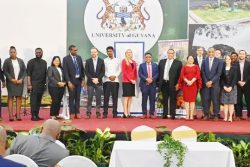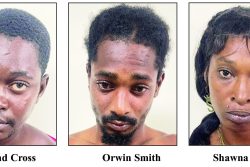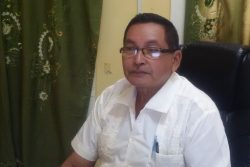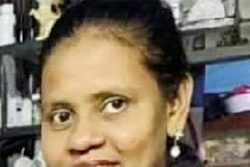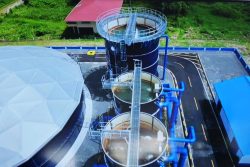Here we are about to enter the New Year with one of the highest poverty rates in Latin America, according to a World Bank report in October. In an updated fact sheet on which we reported last month, the institution said that the share of the population living below US$5.5 a day stands at around 48%. It went on to say: “Poverty rates are highest in the sparsely populated interior or hinterland, where communities have limited access to economic opportunities, healthcare and public services. The country experiences high emigration and brain drain, with 39% of all Guyanese citizens currently residing abroad and roughly half of all Guyanese with a tertiary education having emigrated to the United States.”
Reading the cheery press releases from the DPI about our phenomenal growth rate and all these massive infrastructural projects that are either underway or about to be embarked on, no one would believe that 48% of our population was living in extreme poverty. But then perhaps for the government and those who serve it, statistics are just abstractions which do not translate into real people or real suffering. They consider their responsibility to communities discharged when they sprint into a village and agree to rehabilitate a community ground or fix a local road.
However, Sunday Stabroek gave extreme poverty outside Georgetown a human face when it published a report on Parika Sea Dam in its Christmas Day edition. The families who live here for the most part do not know where their next meal will come from. They live in run-down shacks which they lack the resources to rebuild or fix properly, and we carried photos to give readers an idea as to what was involved. At the moment the situation is even worse than usual because of the flooding, although the residents normally have to face this in any case during the spring tide. It was no surprise to learn that the mud road was in a deplorable state with huge potholes which filled with water after every rainfall, while the children found it difficult to negotiate their way to school and clean their muddied footwear.
There is no running water, so rainwater has to be collected for cooking and drinking purposes, and of course there is no electricity. Needless to say too, the area has not been regularised and no one in authority has ever come to see them to make an assessment. This is despite the fact that the settlement has been there for forty years when residents first arrived as squatters because they had nowhere else to live. There was Mr Ramesh Takah, 44 years of age, who suffers from severe diabetes which has not been brought under control and is now affecting the vision in his right eye.
He was feeling very stressed when our reporter visited because he was unable to do any gardening owing to the flooding. With a wife, six daughters and a son to maintain, he works as a labourer on a boat but is unable to do that at the moment owing to his health. He sometimes earns a little money to “watchman boats” as he put it, when they dock near his home.
Then there was Ms Nandranie Budhoo, 27 years old, who has three sons aged two, seven and eight. As we reported, her husband is a pushcart operator, and while he had brought home some money the day before, there were many days when he would return empty handed and there would be no money for food. They live in what was described as a ramshackle house with rusted roofing sheets which were perforated and through which the water leaked. They had put a tarpaulin on the roof, but that had not proved a fully effective deterrent against the entry of the rain, and so then they would place a saucepan to catch the water. They had few household items, said our reporter, and these included a “bed, a little chair, a kerosene stove and some plates and cups”. Ms Alita Singh, 22 years old, was standing at the bottom of the stairs of her derelict home when SN visited. She was pregnant, and had two children aged three and four. The rotting house which belongs to her mother was leaning on one side, and the veranda collapsed recently. Her reputed husband does maintenance work on the boats, but it is not regular, and he barely earns enough to provide for the family. Ms Elizabeth Bowlin’s tiny shack has no bedroom and only a little space for their kitchen and a bed. Her husband uses a spot outside the house to carry on his work as a barber, but he does not get work every day. She has two children, aged 15 and two. Sabita Venus too finds life hard. Her husband is a pushcart operator and she has a thirteen-year-old daughter.
So what does one say about a country which has had what the World Bank described as extraordinary economic growth of 20-40% over the last two years that brought GDP per capita to over US$9,300 in 2021? It might be remarked that that figure will be even higher now. But what does a GDP per capita figure of US$9,300 mean to people who live in broken-down shacks and don’t know where their next meal is coming from?
Our politics has been poisonous of course. Our politicians have been mainly obsessed with each other, and their interest in voters has always revolved around ensuring that they cast their ballot for the ‘right’ party, whichever that may be. Where ordinary people are concerned, as opposed to the very affluent, political allegiances have been defined by ethnicity, not by which party will best help the impoverished of all races. It is only very recently it is true, that a government has had the financial resources to make poverty a thing of the past, but perversely, this administration appears to be operating on a trickle-down basis, an approach which has long since been found to be flawed.
The first thing any administration needs to do in order to find out exactly how much extreme poverty exists and where it is to be found, is to actually go out in the field to assess the situation. Why is it that we are always reliant on organisations like the World Bank for knowledge about ourselves? At least where the coast is concerned, local authorities should be roped in and charged by central government to identify areas like Parika Sea Dam, and give numbers, etc.
On the basis of that information the various ministries could visit and interview residents. As said earlier, they are already hurtling into NDC areas at a senior level to find out what the residents want, so there should be no particular challenges identifying officials to undertake exchanges with the truly poor who fall outside the system and listen to how they think they might best be helped. Responses to needs no doubt would vary according to area and individual, but one suspects that in the first instance at least the authorities would need to adjust some existing policies, particularly in the matter of housing. Perhaps they should look at social housing, as is done in some other parts of the world, which would involve no financial outlay on the part of the resident initially, but who could make payments according to capacity over time.
At the time the report on the World Bank figures was published the Leader of the Opposition condemned the government in a press release for its inaction on poverty. It might be said that his party has a role to play as well. The urban areas are under APNU control, so what is preventing their local authorities from identifying sectors or streets or even families where extreme poverty is in evidence. Furthermore, he does not have to confine himself to local authorities where his own party is dominant.
He could send his members along the coast to all areas including Indian ones, to catalogue zones where true poverty exists. At the moment he is consumed by political cases in the courts, but whatever happens here it will not help his constituents, it will not help his party and it certainly will not help the impoverished.
The most difficult part of the country to deal with is the hinterland, where the highest rates of extreme poverty exist. The problem is made more acute not just by the geography involved, but also because all governments in this country have had a paternalistic attitude to the Indigenous people heavily contaminated by politics. They are simply not in the habit of taking on board what the village councils tell them they want, let alone truly consulting them or listening to them in the first place. Dr Janette Bulkan’s letter which also appeared in our Christmas Day edition about the carbon credits scheme is an excellent illustration of this.
Eliminating extreme poverty in this country, therefore, will be a matter of consultation and not simply imposition from above. And consultation is certainly not this government’s strong suit.
The money is certainly there to do it; as we reported Guyana has earned about US$2 billion in oil money over the last three years. Why, it might be asked, are we then wasting it on dubious projects like the gas to shore enterprise whose benefits are uncertain for everyone, and non-existent for Mr Takah, Ms Budhoo, Ms Singh, Ms Bowlin, Ms Venus and thousands more like them who are living in shacks, and many of whom are not even guaranteed a meal every day?


